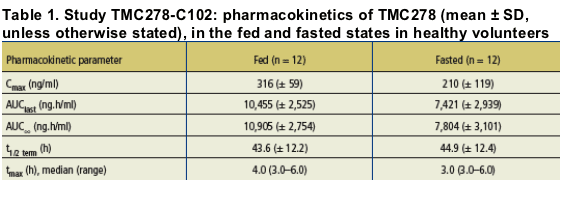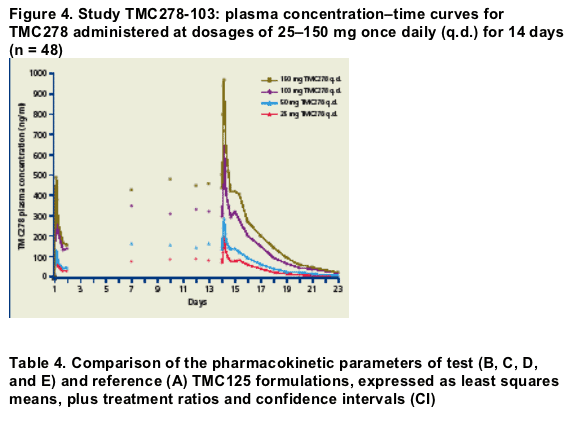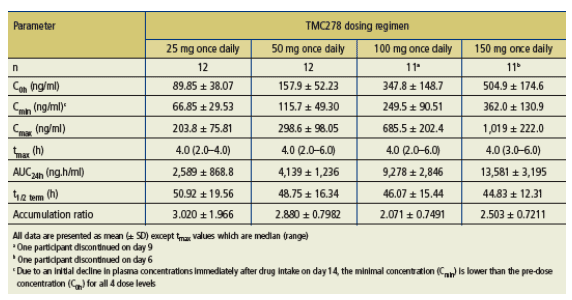 |
 |
 |
| |
Effect of food and multiple-dose pharmacokinetics of TMC278
as
an oral tablet formulation: healthy volunteers
|
| |
| |
Reported by Jules Levin
Intl AIDS Society Conference
Rio de Janeiro
July 24- 27, 2005
Poster No. TuPe3.1B10
Hoetelmans R, Van Heeswijk R, Kestens D, Marien K, Stevens M, Peeters M,Williams P, Bastiaanse L, Buffels R and Woodfall B
Tibotec, Mechelen, Belgium
AUTHOR CONCLUSIONS:
TMC278 should be administered with food as in vivo exposure to TMC278 is increased by approximately 45% compared with administration in the fasted state.
- When administered under fed conditions, the maximum plasma concentration of TMC278 (Cmax) and AUCĄ were approximately 71% and 45% higher, respectively, compared with fasted conditions (P = 0.0067 and P = 0.0016, respectively).
- The single- and multiple- dose PK of TMC278 when administered as an oral tablet formulation are dose- proportional over the range 25- 150 mg once daily.
- Steady- state conditions are reached within 1 week of commencing once- daily oral administration.
- Accumulation ratio, tmax and t1/2 term are independent of dose; all other variables (including AUC24h and Cmax) increase in proportion to dose.
- A Phase IIb trial is ongoing with this tablet formulation taken after food at dosages of 25- 150 mg once daily.
TMC278 (formerly known as R278474) is a DAPY that is being evaluated as a once daily oral NNRTI for use in HIV- infected individuals, including those infected with virus resistant to current NNRTIs. It is currently being studied in a Phase IIb clinical trial in antiretroviral- naive HIV- 1 infected subjects, in combination with nucleoside reverse transcriptase inhibitors (NRTIs).
TMC278 has a favourable pharmacokinetic (PK) profile, allowing low doses (25- 150 mg) to be given once a day.8
We conducted studies in healthy volunteers to investigate:
(i) the effect of food on the PK of TMC278 (Study TMC278- C102);
and (ii) the multiple- dose PK of TMC278 at various doses (Study TMC278- C103).
METHODS
TMC278- C102
- TMC278- C102 was an open- label, randomized, single- dose crossover trial to evaluate the effect of food on the oral bioavailability of TMC278 100 mg tablets in 12 healthy volunteers (Figure 2a).
- For fed conditions, the trial medication was administered within 10 minutes after a standardized breakfast, consisting of 4 slices of bread, 2 slices of ham or cheese, butter, jam and two cups of decaffeinated coffee or tea with milk and/or sugar (estimated 600- 800 kcal, 25- 35 g of fat).
- For fasted conditions, participants were required to have fasted for at least 10 hours before dosing. All participants received lunch 4.5 hours after dosing.
- The PK profile of TMC278 was assessed during 216 hours after dosing.
TMC278- C103
- TMC278- C103 was an open- label, randomized, multiple- dose ranging trial to evaluate the single- dose and steady- state
PK of TMC278 at 4 doses (all administered with food) in 4 panels of 12 healthy volunteers each (Figure 2b).
- Doses of TMC278 studied were 25 mg, 50 mg, 100 mg and 150 mg, each administered once daily for 14 days.
- The PK profile of TMC278 was assessed during 24 hours after dosing on day 1 (single- dose) and during 216 hours after dosing on day 14 (multiple- dose).
- Additionally, pre- dose plasma concentrations were measured on days 7, 10, 12, 13 and 14.
RESULTS
TMC278- C102
- All 12 participants were Caucasian males; the median age was 35.5 (range 25- 53) years, and the median body mass index was 25.6 (range 21- 29).
- TMC278 plasma concentration- time curves for fed and fasted subjects during the 48 hours immediately following dosing are presented in Figure 3. Summary PK parameters are given in Table 1.
TMC278 plasma concentrations were higher overall when doses were administered with food, compared with fasted conditions.
- The bioavailability of TMC278 was higher under fed conditions compared with fasted conditions, as indicated by the higher values for area under the plasma concentration- time curve (AUC).
- Time to maximum concentration (tmax) was slightly shorter under fasted conditions, while the elimination half- life (t1/2) was comparable between groups.


- When administered under fed conditions, the maximum plasma concentration of TMC278 (Cmax) and AUCĄ were approximately 71% and 45% higher, respectively, compared with fasted conditions (P = 0.0067 and P = 0.0016, respectively).
TMC278- C103
- Baseline characteristics for the 48 participants in the trial are shown in Table 3.
- Participants were generally well matched across study groups. All participants except one were Caucasian.

Plasma concentration- time curves for each dosage group are presented in Figure 4.
- The shape of the plasma concentration- time curve was similar for all dose levels. Plasma concentrations increased in a doseproportionate manner over the dose range studied.
- After single- dose administration on day 1, plasma concentrations increased to a maximum at 4 hours post- dose for all dose levels.
- After multiple dosing, on day 14, plasma concentrations initially declined in the first hour after administration in most subjects, for all dose levels.
- Multiple absorption peaks were noticed for most of the subjects, with a plateau or a second or third absorption peak in the period 24- 32 hours.
- Pre- dose plasma concentrations on days 7, 10, 12, 13 and 14 indicate that steady state was reached within 1 week of commencing once- daily oral administration.
- Steady- state PK parameters are presented in Table 4.


Accumulation ratio, tmax and elimination half- life (t1/2 term) were independent of dosage. All other parameters increased in a dose- proportionate manner.
- At steady- state, AUC24h was 2- to 3- fold higher compared with AUC24 on day 1, which is in good agreement with the mean t1/2 term of 45- 50 hours.
- Statistical evaluations of the least squares means derived from primary and dose- normalized PK parameters are presented in Table 5.
- As there are no significant differences between least squares mean dose- normalized PK parameters (P > 0.05 for all parameters examined), the PK of TMC278 are dose- proportional.

REFERENCES
1. Moyle G. Drugs 2001; 61:19- 26.
2. Antinori A, et al. AIDS Res. Hum. Retrovir. 2002; 18:835- 838.
3. Harrigan PR & Larder BA. Antimicrob. Agents Chemother. 2002; 46:909- 912.
4. Andries K, et al. Antimicrob. Agents Chemother. 2004; 48:4680- 4686.
5. Gazzard B, et al. AIDS 2003; 17:49- 54.
6. Grudez B, et al. AIDS 2003; 17:2487- 2494.
|
|
| |
|
 |
 |
|
|